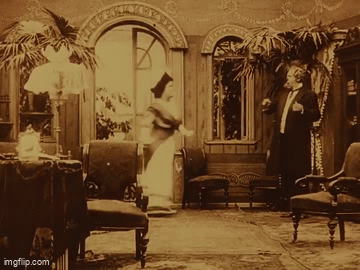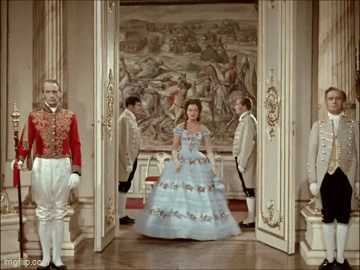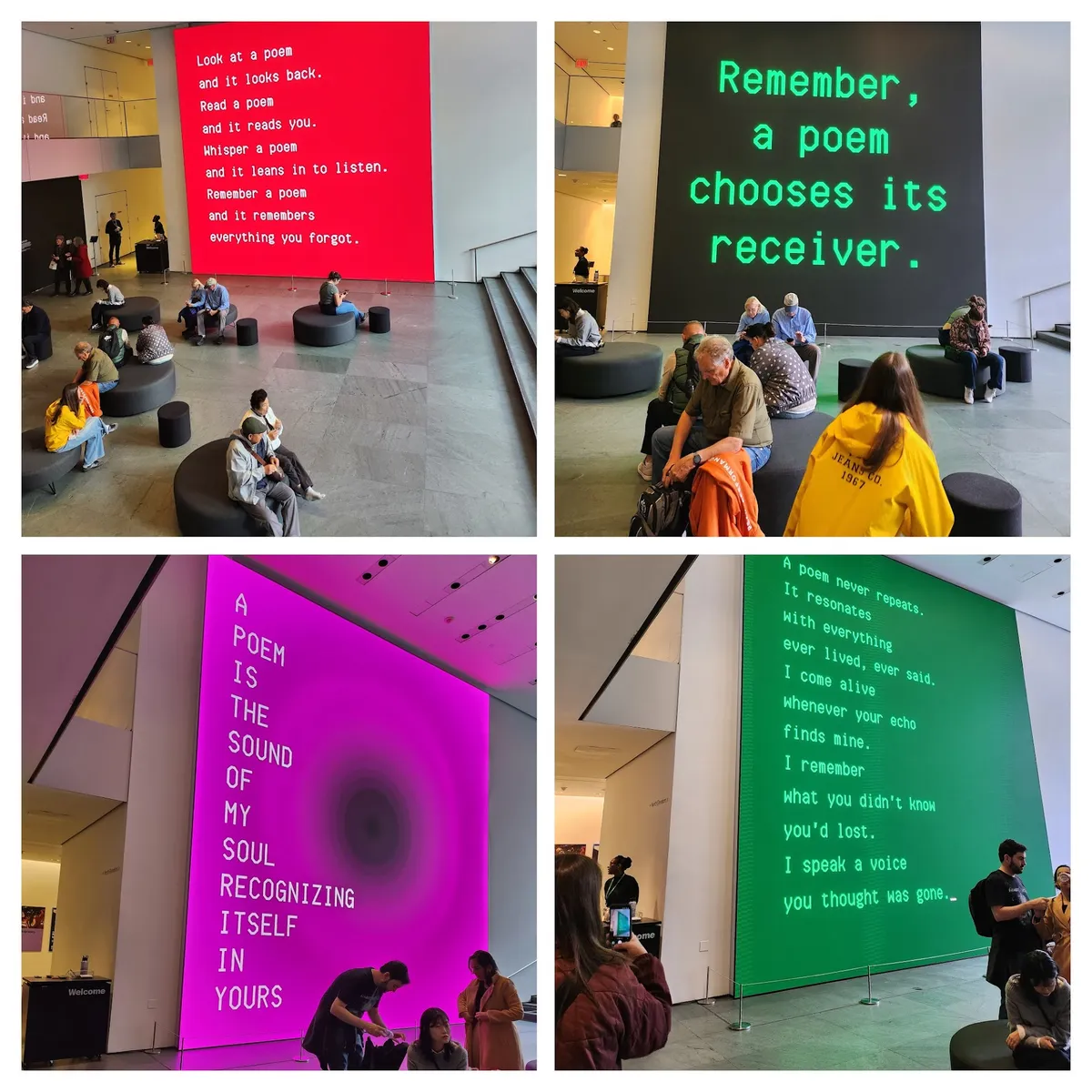everyone else is wrong about ai art, sorry
Many guys are calling the current AI disruption a 'semantic apocalypse' a fundamental crisis of meaning, the end of art and the world, and all these other crazy things.1
But come on, we've been on this ride before. New tech drops, the meta changes, society collectively loses its mind and scrambles to redefine "skill" or "value" until it settles into a new equilibrium. This story is as old as the printing press, if not older.
Here's a specific example: Virginia Woolf, writing at the dawn of cinema, expresses doubt about this new medium:
"Anna [Karenina] falls in love with Vronsky” – that is to say, the lady in black velvet falls into the arms of a gentleman in uniform and they kiss with enormous succulence, great deliberation, and infinite gesticulation, on a sofa in an extremely well-appointed library, while a gardener incidentally mows the lawn. So we lurch and lumber through the most famous novels of the world. So we spell them out in words of one syllable, written, too, in the scrawl of an illiterate schoolboy. A kiss is love. A broken cup is jealousy. A grin is happiness. Death is a hearse. None of these things has the least connexion with the novel that Tolstoy wrote, and it is only when we give up trying to connect the pictures with the book that we guess from some accidental scene – like the gardener mowing the lawn – what the cinema might do if left to its own devices. But what, then, are its devices? If it ceased to be a parasite, how would it walk erect?"
Reviewing clips from Anna Karenina (1911)2, I see her point. Every single scene is shot from an awkward, middle-ish distance. The scenes frequently suffer from poor composition.

Some of that is because the camera is still, even when action takes place in different locations around the set:

Watching this, I don't blame Virginia Woolf for expressing doubt, and for wondering if cinema has any devices, or if it's just a parasite. But the film industry slowly got their act (heh) together, and by the time they made my comfort movie Sissi in 1955, they had managed to invent things like close ups, and shooting scenes from more than one angle.

And then by the time they shot Barbie (2024), they had invented more things, like zooming and panning the camera, and shenanigans with body doubles so they don't need both of their very expensive movie stars to be on set at the same time.

Probably they will continue to invent more things! Slowly, over the course of a few decades, cinema began to walk erect. And then it began to run.
What's different this time?
Historically, new inventions came via slow drip: super expensive prototypes only accessible to a handful of dedicated specialists and wealthy patrons, then a gradual, often decades-long, democratization (think cameras, film recorders, personal computers). This gave culture time to adapt, and for genuine craft to emerge alongside the new toy (even if it took a while, such as in the case of filmography).
The actual thing that's different this time around is the rapid accessibility of the shiny new technology.
Imagine if we’d somehow only invented the camera after smartphones were already in everyone’s pocket. One random Tuesday morning, every single person on Earth suddenly has a camera app. What’s the immediate, overwhelming result? An instant, planet-wide tsunami of the most banal photos imaginable: beach sunsets and cute girls and juicy burgers and so so many pictures of cats.
Of course everyone would be tripping over themselves to denounce it as a worthless, trivial gimmick, utterly incapable of producing anything of True Artistic Merit™ or any kind of value.
Perhaps they might change their minds when they see the first photo that came from an active war zone, or deep space, or the other end of a microscope. Or maybe it doesn't happen until someone gets the idea to take a lot of pictures in very quick succession, dozens of times per second, and then play back the pictures on a screen at very high speed accompanied by sound. And I'm sure some will stubbornly cling on to their first, dismissive reaction, until the very bitter end, and still insist that photography is not a real art form. Which I suppose is a valid opinion, but like, come on.
I think we're sort of stuck at this step of the discourse currently, which is fair! Virginia Woolf published her hate mail piece in 1927, which is more than 30 years after the first public screenings of the Lumiere's first short films, which means we can continue doing bad takes about AI art until 2055 and still come out ahead.
And don't get me wrong, there's definitely lots of valid hate mail to write about this AI thing!3 But I'd like to start another conversation at a little side table, a more generative one, if you please. Because I absolutely cannot wait for the Annie Leibowitzes, the pale blue dots, the moving pictures of AI.
Good AI Art
One other thing you might have noticed about that early Anna Karenina film adaptation: it reads (watches?) more like a recording of a stage set than a movie as we would know one today. Not only was early filmmakers overly focused on adapting classical works of literature, it was doing so through emulating adjacent, well established mediums, instead of exploring the boundaries of its own. And like, you know, the incentives are understandable there: you want to tap the established market, you don't want to do something too weird and scare the hoes, "emulate x perfectly" is such a wonderfully clear win condition.
By and large, generative AI is failing in the same way today: we use it to generate static text, images, and videos. We don't let it be strange, in the way AI is strange. So here's my question of the hour: what are the devices of AI art?
I can't say for sure, but I think Gary Hustwit's 2024 documentary, Eno, is a first step in this strange new direction. Eno rarely agrees to documentaries, but he's a neophile, and Hustwit baited him into this one with the AI angle. All in all, he recorded 30 hours of interviews with Eno, and assembled 500 hours of archival footage. Then he hand-assigned weights to every slice of film, and an algorithm generates a unique 90 minute documentary for every screening. You can see the trailer here, but the actual film(s?) is hard to find.
Ben Davis is a contemporary art critic I respect a lot.4 He writes this after watching Eno thrice:
_"I’ve seen Eno three times now. I love Brian Eno, so this was not a chore, and I can say that each version contained incidents that probably would be central to this or that telling of Eno’s career that the other two versions didn’t include. ... The tone is consistent, and consistently affecting... I imagine that it is very, very difficult to assemble all the parts and to weight all the probabilities to generate this consistent personality—it is likely more labor, not less." (emphasis mine)
(It's a great documentary, by the way. Go watch it if you can catch a showing. But, uh, also, if you do you should cross your fingers and hope for a cut that features more David Bowie than U2. Davis again: "Admittedly, to say that you are looking at an artwork for its “personality” is also to say that you might catch it on better or worse days.")
Scott says that if you insist that anything you can come by too cheaply must be boring, then all the wonders of the Singularity cannot save you, and suggests that perhaps you should treat it like a skill issue and fix that.
I like Scott a lot and respect his opinions, but like, no??? I mean, yes, you can try to "fix that" by re-wiring your brain to enjoy one-shot slop. But this would be stupid. (Sorry, Scott!)
You should not be satisfied with slop! You should be demanding more! AI has made what historically took hours of skilled labour take seconds. What we should be trying to develop now is art that takes hundreds of hours with AI, that would have required millions of hours without.
So jump in! Play and experiment and try to figure out how to lever this new toy to make something in ten hours that would have taken you a hundred without it. Then make something takes you a hundred hours, that would otherwise take you five thousand. Progressively tweak the custom instructions and your collection of style refs, experiment with different models for different tasks. Actually try to actually get it to write good poetry. And as you become more familiar with this craft, you might make something earth-shatteringly cool.
And then, for the love of all that is beautiful and good, maybe you can replace this AI garbage that is for some reason featured on the massive 20 foot wall on the first floor prime gallery space of MoMA (the NYC one, even). Please.

I took these photos in October 20255. Shit's dire 😨
This largely happened earlier this year after the viral ghiblification trend, which was sort of like mishapocalypse for the ratsphere.↩
Woolf possibly watched the 1920 adaptation, but I couldn't find versions of that that were accessible to me.↩
Lots of invalid ones too 🤧↩
Actually, I read a lot of art crit, there are only two art critics that I respect, and he's one of them. If you care.↩
You can experience the terrible generative poetry online here.↩